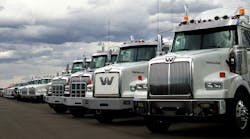Manager: Victor Domenico
Title: Owner, president
Fleet: Domenico Transportation
Operation: 35 power units
PROBLEM
When you're piloting big rigs up and over two-lane blacktops reaching 12,000 ft. into the sky, brakes aren't just a line item on a spec sheet anymore — they become a matter of life or death for truckers.
Victor Domenico knows that all too well, as he spent nearly a decade delivering grocery items via tractor-trailer to stores dotting the ski resorts throughout his native Colorado. Often navigating tight two-lane roads winding through Loveland Pass and Rabbit Ears Pass, Domenico made sure his brakes were always in tip-top shape before going out on a run.
When he started refrigerated carrier Domenico Transportation in 2000, he continued to look for ways to beef up the stopping power on his big rigs. “It's not easy trucking out here. It's not for the faint of heart, that's for sure,” he says.
Along with foodstuffs for the ski communities, his fleet also delivers flowers and other goods throughout neighboring states and into the Dakotas. On top of that, Domenico's fleet is also a slip-seat operation, with the newest trucks accumulating between 180,000 to 220,000 mi. per year as they roll 20 hours a day, seven days a week.
That's why brakes play such a critical role within the “mountain specs” Domenico develops for his fleet, as the trucks not only must navigate in hilly terrain, but do so over very long stretches of time and in all types of weather conditions.
SOLUTION
When wide-base tires started hitting the market, Domenico adopted them for his fleet of 32 Kenworth T800s and three Kenworth T660s. He also went to bigger 9-in. drum brakes. “The larger wheel size allowed us to use bigger drum brakes, yet in the end, they were still just bigger versions of current technology,” he said.
As soon as air disc brakes became an option, Domenico jumped at the chance to equip three of his trucks with the brakes.
“It's really all in the physics of how these brakes operate,” he explained. “When drum brakes heat up from frequent use and expand, they move away from the rotors, reducing stopping power. When disc brakes get hot and expand, they move closer to the rotor. That's why you don't get brake ‘fade’ with them, which is why they are ideal for trucks and cars alike.”
Yet disc brakes can be pricey when compared to their drum brethren — about $1,200 to $1,300 more per vehicle, according to Meritor Wabco. It's from a maintenance perspective, however, that Domenico found air disc brakes actually saved the company money over the long run when matched against drums.
“First, we've found we get 50% longer life on our brake liners by using disc brakes as opposed to drums. They really last. We have some with close to 400,000 mi. on them, and they still don't need replacing,” he said. “Our trucks stop on a dime, and no water or corrosion can get inside the brakes since they're sealed.”
Second, it takes his technicians half as much time to replace air disc liners versus drums. “Those are big added pluses for our operation,” Domenico noted. “But at the end of the day, it's still all about safety. That's why we went with air disc brakes in the first place.”
Maintenance Bay presents case studies detailing how fleets resolve maintenance-related issues.


